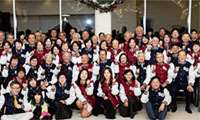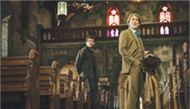By JIM ROBBINS BOZEMAN, Montana - Not long ago, Ed Adams, a civil engineering professor, studied avalanches by setting them off with dynamite and studying their movement as they buried him, his instruments and his colleagues in a tiny shack.
Recently, though, Dr.Adams, a 58-yearold materials researcher, started a new and somewhat quieter phase of research, studying avalanches in the lab at Montana State University. A $2 million “cold lab”financed primarily by the National Science Foundation and the Murdock Charitable Trust and completed here in November allows Dr.Adams to replicate and control the uncontrollable field conditions of mountains in winter and understand in detail how snow behaves under widely varying conditions. The goal is to be better able to predict an avalanche.
“Snow seems simple, but it’s extraordinarily complex,”Dr.Adams said.“If I set a box of snow in the refrigerator and come back in an hour, it’s changed significantly. It’s almost always in a constant state of motion, and studying it is a moving target.”That is where the lab comes in, allowing researchers to vary the sky, sun and temperature to see how snow responds.
There have been 31 avalanche fatalities in North America this season through January 19, 16 in the United States and 15 in Canada. The record in the United States is 35 in the winter of 2001-02.
“The number of fatalities we have had shows they’re a difficult phenomenon for us to understand,”said Karl Birkeland, an avalanche scientist at the Forest Service’s National Avalanche Center here. “There’s definitely a need to better understand them.”
Montana State is well situated for the study of avalanches. There are four Class A avalanche zones? the most severe? at nearby skiing areas, and numerous backcountry locations for study.
For years, Dr.Adams and his colleagues set up their instruments in a small shack on a steep slope at Bridger Bowl, about 24 kilometers from the university, and sent another researcher up the slope to ignite a one-kilogram bomb that set off an avalanche.
As the wall of snow rumbled around or over the shack, Dr.Adams, bundled up against the cold, watched his laptop record information on velocity, depth, flow and temperature. He estimates he has survived dozens of such self-inflicted avalanches.
In the cold lab, however, where the temperature is 22 degrees below zero Celsius, the focus is on a one-square-meter panel, brilliantly lighted by an artificial sun and watched over by an icy artificial sky that can be widely varied to replicate different winter conditions. Wearing his puffy down jacket, wool hat and sunglasses, Dr.Adams shows how he can reproduce the wide range of conditions found on mountain slopes and create different types of snow.“We want to understand what conditions cause the change in the crystalline structure and the bonding between crystals,”he said.
Once he and his students and colleagues have created the snow crystals under certain conditions, they put them under the microscope to see what conditions made for the strongest or weakest layers.
The biggest cause of avalanches is a weak layer of snow on a slope covered by solid layers, Dr.Adams said.“The weak layers are faceted crystals, very smooth and unbonded to each other,”almost like ball bearings, he said. Strong layers have stronger bonds between crystals, which makes them more stable.
“It’s like a layer cake with very weak frosting,”Dr.Adams said. When something causes the weak layer, usually less than 2.5 centimeters thick, to give way, the strong layer or layers? there can be dozens, some of them a meter thick or more? go with it. Even skiing at low altitudes can fracture a weak layer and set off an avalanche far above. Contrary to conventional wisdom, sound, unless it is from an explosion, does not set off avalanches.
Based in the jagged mountains of the northern Rockies, the avalanche center at Montana State was founded by Charles Bradley and John Montagne, veterans of the Army’s Tenth Mountain Division who came here after World War II.
Other major avalanche centers include the Swiss Federal Institute for Snow and Avalanche Research in Davos, the world’s largest, and the Nagaoka Institute for Snow and Ice Studies in Japan.
The best way to survive an avalanche is still not clear. Some researchers say the most critical thing is to create a pocket in front of the face to breathe while waiting for rescue.
“I would swim, though,”Dr.Adams said.“Get prone in the snow and stay on top.”
스마터리빙
more [ 건강]
[ 건강]이제 혈관 건강도 챙기자!
[현대해운]우리 눈에 보이지 않기 때문에 혈관 건강을 챙기는 것은 결코 쉽지 않은데요. 여러분은 혈관 건강을 유지하기 위해 어떤 노력을 하시나요?
 [ 건강]
[ 건강]내 몸이 건강해지는 과일궁합
 [ 라이프]
[ 라이프]벌레야 물럿거라! 천연 해충제 만들기
 [ 건강]
[ 건강]혈압 낮추는데 좋은 식품
[현대해운]혈관 건강은 주로 노화가 진행되면서 지켜야 할 문제라고 인식되어 왔습니다. 최근 생활 패턴과 식생활의 변화로 혈관의 노화 진행이 빨라지고
사람·사람들
more많이 본 기사
- 신혼부부 ‘역대 최저’ 24%는 3억 이상 대출
- 통일교 특검 대신 “내란 2차 특검”… 민주당 ‘철벽 방어’
- 제미나이 추격 오픈AI 새 모델 GPT-5.2 조기 공개
- TV 나와 암투병 근황 공개한 찰스 英국왕… “조기검진 중요해요”
- AI공급망 동맹 ‘팍스 실리카’ 8개국 참여
- “한국, 재래식 방위주도” 한미 핵협의그룹 첫 명시
- 굽히지 않는 젤렌스키…트럼프에 역제안 카드로 레드라인 저지
- 선교사 아들 가나대사로 금의환향… “한국·가나는 두 어머니”
- 송지효 “’런닝맨’ 출연 중 8년 ♥장기 연애했다” 폭탄 고백..멤버 모두 ‘충격’
- 변요한♥티파니, 결혼 전제 열애 인정
- 또 복권열풍⋯파워볼 잭팟 10억달러로
- 소셜연금 NY 2,018달러·NJ 2,190달러
- “’삐빅’ 비트코인으로 결제할게요”…맥도날드·편의점서도 쓴다는 ‘이곳’, 어디?
- 美지상작전 임박설 속 베네수 이민자 송환 중단 놓고 ‘혼선’
- 워싱턴주 홍수로 수만명 대피…주지사 “유례없는 상황 직면”
- 세모(歲暮)를 보내는 마음
- ‘고가 논란’ 북중미 월드컵 티켓, 판매 첫날 500만건 신청
- 한화, 호주 방산업체 최대주주 된다
- 젤렌스키 측근 협상가가 FBI국장을 왜?…비밀회동 목적 의문
- ‘나혼산’ 박나래, 흔적도 없이 하차… 1
- 종묘 일대 세계유산지구로 세운4구역 개발 영향 줄까
- 트럼프, 중남미 마약카르텔 공습 확대의지… “지상서도 시작한다”
- 뉴욕증시, 브로드컴 비관론에 AI 테마 ‘와르르’…나스닥 1.7%↓ 마감
- 美 레전드 깜짝 전망 “한국, 북중미 월드컵 A조 1위로 32강”
- “귀금속 역사상 가장 극적인 재평가”…올해는 銀이 金 앞섰다 [공준호의 탈월급 생존법]
- 주한미군사령관 “전작권 전환, 시기보다 조건 봐야”
- 한국 교사 10명, 페어팩스 초등교 배치
- “마약밀매·인신매매 등 국제범죄 척결” ‘국토안보 태스크포스’ 뉴욕지부 출범
- 한국도 참여한 美주도 AI 동맹 “비시장적 관행에 공동 대응”
- ‘공공임대, 역세권에 국평으로’ 주문한 이대통령
- ‘정국 열애설’에 뿔난 아미 ‘워워’..BTS 완전체, 전역→웃으며 연습실 회동 첫 인증샷
- ‘양육비 미지급’ 김동성 “내가 月700만원? 통장 압류된 신용불량자”
- 김지민 “유부남과 불륜, 날 알리바이로 이용”..친구와 손절한 사연 [이호선의 사이다]
- 민주, 트럼프와 여성들 함께 찍힌 ‘엡스타인 사진’ 공개…엡스타인 저택서 확보한 19장에 빌 클린턴·빌 게이츠 등 유명 인사
- 국힘·개혁신당 “통일교 특검 수용하라”…與 “정치공세·물타기”
- 우크라 “러 점령 쿠피안스크 일부 탈환”…젤렌스키 방문
- “머스크의 X, 3분기 매출 7억 달러대…순손실 5억 달러대”
- 19개주, 트럼프 전문직 비자 ‘10만불 수수료’에 소송
- 챗GPT서 ‘포토샵’ 무료 오픈AI·어도비 합의 발표
- “보안사고 반복 땐 과징금 폭탄”… 해킹과 전면전 선포한 과기부
- 김민선 학장 자선행사서 40만달러 기금조성
- ‘오바마케어 보조금’ 올해 말 종료 가능성 ↑ 커져
- 무단 주차 견인료 150불⇨ 210불
- 이민자 추방 전용기 6대 구매 불체자 100만명 추방 속도전
- 이란, 노벨평화상 수상자 모하마디 또 체포… “불법 구호 외쳐”
- FDA, 우울증 치료 ‘뇌 자극’ 가정용 헤드셋 기기 첫 승인
- 미일 ‘팍스 실리카’ 협력 문서 서명
- 경기고 56회 동창회, 더나눔하우스에 후원금 전달
- “엔비디아, 中수요 반영 H200 증산”…일각선 “中, 수입거부할듯”
- 미네소타 보조금 사기, 안보 문제로 비화…월즈 ‘곤혹’
1/5지식톡

-
 테슬라 자동차 시트커버 장착
0
테슬라 자동차 시트커버 장착
0테슬라 시트커버, 사놓고 아직 못 씌우셨죠?장착이 생각보다 쉽지 않습니다.20년 경력 전문가에게 맡기세요 — 깔끔하고 딱 맞게 장착해드립니다!장착비용:앞좌석: $40뒷좌석: $60앞·뒷좌석 …
-
 식당용 부탄가스
0
식당용 부탄가스
0식당용 부탄가스 홀세일 합니다 로스앤젤레스 다운타운 픽업 가능 안녕 하세요?강아지 & 고양이 모든 애완동물 / 반려동물 식품 & 모든 애완동물/반려동물 관련 제품들 전문적으로 홀세일/취급하는 회사 입니다 100% …
-
 ACSL 국제 컴퓨터 과학 대회, …
0
ACSL 국제 컴퓨터 과학 대회, …
0웹사이트 : www.eduspot.co.kr 카카오톡 상담하기 : https://pf.kakao.com/_BEQWxb블로그 : https://blog.naver.com/eduspotmain안녕하세요, 에듀스팟입니다…
-
 바디프렌드 안마의자 창고 리퍼브 세…
0
바디프렌드 안마의자 창고 리퍼브 세…
0거의 새제품급 리퍼브 안마의자 대방출 한다고 합니다!8월 23일(토)…24일(일) 단 이틀!특가 판매가Famille: $500 ~ $1,000Falcon: $1,500 ~ $2,500픽업 & 배송직접 픽업 가능LA…
-
 바디프렌드 안마의자 창고 리퍼브 세…
0
바디프렌드 안마의자 창고 리퍼브 세…
0거의 새제품급 리퍼브 안마의자 대방출 한다고 합니다!8월 23일(토)…24일(일) 단 이틀!특가 판매가Famille: $500 ~ $1,000Falcon: $1,500 ~ $2,500픽업 & 배송직접 픽업 가능LA…
케이타운 1번가
오피니언

22기 LA평통 출범에 거는 기대

연말 시즌 사기·범죄 경계해야
 메건 매카들 워싱턴포스트 칼럼니스트
메건 매카들 워싱턴포스트 칼럼니스트 [메건 매카들 칼럼] 장편영화의 마지막 챕터인가
 김미선 서북미문인협회 회장시인
김미선 서북미문인협회 회장시인 [한국춘추] 하늘을 계산한 사람들, 칠정산
 이희숙 시인·수필가
이희숙 시인·수필가 [금요단상] 그을린 자리에서 다시
 심상용 / 서울대 미술관장
심상용 / 서울대 미술관장 [미술 다시보기] 지옥에 대하여
 서정명 / 서울경제 기자
서정명 / 서울경제 기자[만화경] 주한미군과 ‘도련선 리스크’
 한 영 재미수필가협회 회장
한 영 재미수필가협회 회장 [한영의 독서칼럼] 불안한 사람들
 정영현 서울경제 테크성장부장
정영현 서울경제 테크성장부장 [여명] 콘크리트가 데이터가 됐을 뿐, 달라진 게 없다
1/3지사별 뉴스

“마약밀매·인신매매 등 국제범죄 척결” ‘국토안보 태스크포스’ 뉴욕지부 출범
연방 국토안보부가 10일 ‘국토안보 태스크포스’(HSTF) 뉴욕지부를 출범시켰다.HSTF는 마약 카르텔, 인신매매, 자금세탁, 갱단 등 국제범…
‘오바마케어 보조금’ 올해 말 종료 가능성 ↑ 커져

한국 교사 10명, 페어팩스 초등교 배치
‘글로벌 앰버서더 티처스 프로그램’(Global Ambassador Teachers Program)은 국제 교사 교환 프로그램 가운데 하나로 …
김찬수씨, 포토맥 포럼에 2천달러 기부

초강경 추방 드라이브… 한인사회 불안감 확산
도널드 트럼프 행정부가 출범 직후 불법체류자 100만 명 추방 목표 달성을 위해 초강경 조치를 본격화하면서 미주 한인사회에 불안감이 심각하게 …
<부음> 이명무 전 SF 체육회장 부인상

오늘 하루 이 창 열지 않음 닫기 





















































.png)


댓글 안에 당신의 성숙함도 담아 주세요.
'오늘의 한마디'는 기사에 대하여 자신의 생각을 말하고 남의 생각을 들으며 서로 다양한 의견을 나누는 공간입니다. 그러나 간혹 불건전한 내용을 올리시는 분들이 계셔서 건전한 인터넷문화 정착을 위해 아래와 같은 운영원칙을 적용합니다.
자체 모니터링을 통해 아래에 해당하는 내용이 포함된 댓글이 발견되면 예고없이 삭제 조치를 하겠습니다.
불건전한 댓글을 올리거나, 이름에 비속어 및 상대방의 불쾌감을 주는 단어를 사용, 유명인 또는 특정 일반인을 사칭하는 경우 이용에 대한 차단 제재를 받을 수 있습니다. 차단될 경우, 일주일간 댓글을 달수 없게 됩니다.
명예훼손, 개인정보 유출, 욕설 등 법률에 위반되는 댓글은 관계 법령에 의거 민형사상 처벌을 받을 수 있으니 이용에 주의를 부탁드립니다.
Close
x